Big Little Wolf's Daily Plate of Crazy
Whatever life dishes out, and whatever we can make of it. . .
Beautiful Breasts Cause Controversy in Atlanta
Feb 27th, 2011 by BigLittleWolf
Does the man or woman exist who doesn’t think that breasts are beautiful – in the abstract, or in person?
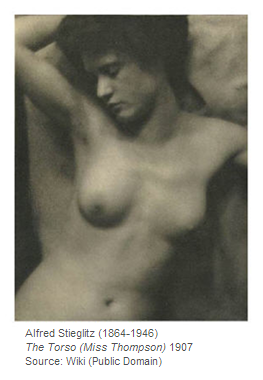 You may like them small and perky, or pear-shaped and voluptuous. Perhaps you prefer them natural, or go ga-ga over ecstatically enhanced E’s. Certainly, in the privacy of our homes (or a French beach?), gazing online, and wandering the hallowed halls of our museums, we pause to admire the bodacious and the demure. The beautiful breast.
You may like them small and perky, or pear-shaped and voluptuous. Perhaps you prefer them natural, or go ga-ga over ecstatically enhanced E’s. Certainly, in the privacy of our homes (or a French beach?), gazing online, and wandering the hallowed halls of our museums, we pause to admire the bodacious and the demure. The beautiful breast.Take a look at this photograph by Alfred Stieglitz, from 1907. This is art. I find it exquisite. But tell me – does it offend you?
Now let’s try another question. Would you hang this photograph in your bedroom, proudly? What about your living room? Would you worry if more conservative friends come to call, or do you not give a damn as long as you love it?
Naked Truth
Are you embarrassed by nudity in general? Do you simply subscribe to the belief that there is a place and time for baring all, literally?
What about art – fine art – the eloquence of the human form, as captured by the lens or the painter’s brush, and offered to the viewer for our interpretation?
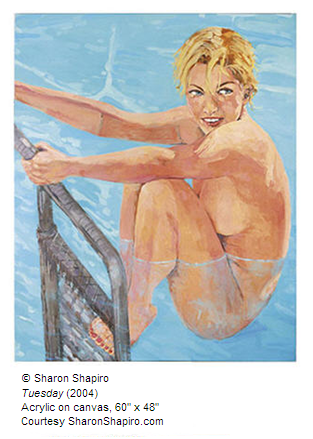 Apparently, there are still places where a skillfully painted nude that is part of a sophisticated narrative is cause for consternation. And controversy. And I stumbled upon one such instance, very recently.
Apparently, there are still places where a skillfully painted nude that is part of a sophisticated narrative is cause for consternation. And controversy. And I stumbled upon one such instance, very recently.Not in front of the children, Dear
From time to time I venture out into the world, generally to see art. I’ve popped over to Paris to view shows (and write about them), and no, not lately. I’ve zipped to New York to indulge my soul (MOMA as Nirvana), and traveled the highway headed to Atlanta (no passport required).
Atlanta is a lovely city, albeit one in which it seems the Real Housewives can strut their stuff with bouncing breasts, beholden to their surgeons, but a gorgeous work of art on a gallery wall?
Not in front of the children, please.
At least, so sayeth a handful of morality gatekeepers, who claimed that the 1960s-themed work of contemporary painter Sharon Shapiro had to be moved to the back, so the ostensibly offending nude would not perturb shoppers in a nearby store – shoppers with children in tow.
And the gallery complied.
Art stirs the soul; and what of the Savage Beast?
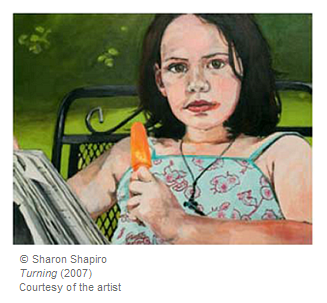 I am an unabashed fan of Shapiro’s work, and have been since I first saw it in the 1990s. Her evolution as an artist (and keen observer of cultural contradictions) has yielded almost 20 years of work that exposes the complex inner world of women, societal expectations, and the murky mix of sexual ambivalence directed toward children as well as adults.
I am an unabashed fan of Shapiro’s work, and have been since I first saw it in the 1990s. Her evolution as an artist (and keen observer of cultural contradictions) has yielded almost 20 years of work that exposes the complex inner world of women, societal expectations, and the murky mix of sexual ambivalence directed toward children as well as adults.Among the works I find most compelling are those in which she addresses the disturbing awareness of budding sexuality in young girls – its purity, which we as adults perceive with wistfulness, and a tinge of (legitimate) worry.
Feminism and Sex
Equally troubling in Shapiro’s work is the issue of child as woman, and woman as child (and implicitly, those men who seem drawn to both). Shapiro’s paintings touch on a range of feminist dealing with sex and power, though all so subtly crafted that it is in looking at Shapiro’s body of work as a whole that we come to understand the questions she challenges us to consider.
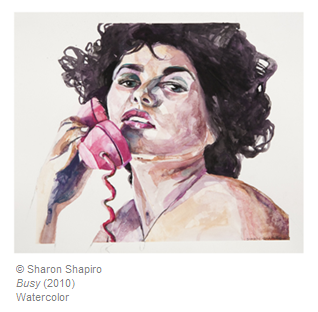 For example, is feminism anti-sex? Is adoration of the female form necessarily exploitation? Is there such a thing as the gently erotic?
For example, is feminism anti-sex? Is adoration of the female form necessarily exploitation? Is there such a thing as the gently erotic?In Shapiro’s alluring imagery, feminism and sex collide, coincide, and reside together as a celebration of the uneasy confines of physical beauty, without denying the need to belong to ourselves. The strong woman is not an unfeminine one, nor is the sexual woman anti-feminist.
Perhaps the artist’s embrace (and fondness) for our collective memory of the 1960s pin-up is just the sort of spark we need for an important conversation. And isn’t this the very same visual and verbal material we’ve come to adore inMad Men - woman rebelling against body image while recognizing its power, not to mention its eroticism?
1960s Womanhood
The Virginia-based artist has been nudging us to examine these themes for years, long before our contemporary fascination with Don Draper’s women.
In her examination of admiration for (and attraction to) woman’s inherent sexuality, it’s hard to deny the pleasure of her palette, the contradictions of its confectionery tones, and equally, the contradictory nature of our prudish American sensibilities which are apparently alive and well, and living in Atlanta. Even on a gallery wall, in a sophisticated commercial district, in a contemporary city – which ought to know better.
Ease
Following Shapiro’s opening of her show, “California” at Atlanta’s Tanner Hill Gallery, and (to the best of my knowledge) three complaints about the large canvas given a prominent position on the front wall, the gallery did indeed cave to public pressure. The painting, (ironically) entitled Ease, was moved.
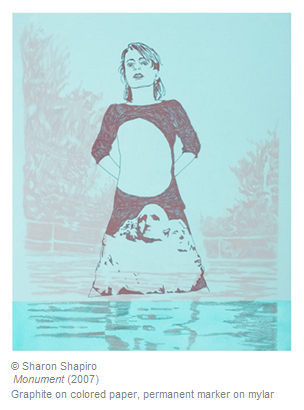 Oh, it doesn’t take many voices to stir up a fuss. Andthis fuss seems oddly anachronistic, when a partial nude that is part of a series painted several years back causes controversy, and a form of passive censorship in a city that could do with better PR than the likes of the Housewife franchise.
Oh, it doesn’t take many voices to stir up a fuss. Andthis fuss seems oddly anachronistic, when a partial nude that is part of a series painted several years back causes controversy, and a form of passive censorship in a city that could do with better PR than the likes of the Housewife franchise.Incidentally, this is a particularly tender showing of Shapiro’s artworks, andEase was originally exhibited in a Charlottesville, Virginia gallery. Without a flap, I might add.
Last I heard, Charlottesville, with its population of less than 50,000, remains more “small town” than Atlanta. At least, one would think so.
However, Atlanta (population 5.4 million) appears to be hanging on to some very small town tendencies. All it takes is a pair that is bare, and this southern city will rise again – calling for the painting to be moved or removed, as it is – or should I say, was – visible from the street and a nearby store.
Sunning and stunning?
I have seen this painting; in fact, I brought my son with me to the opening. Shapiro’s color sense and brushwork are delectable, the image is bold without being brazen, and its context – well, one can quickly imagine this statuesque woman about to sun herself by a private pool in an intimate exhibition that conjures a dream-like version of mid-century California.
I admit that my children have grown up around art, including nudes which hang on our walls and lean against our (uncensored) overcrowded bookcases.
We don’t walk around our house in the buff (though I have no issue with those households that do); I have encouraged a realistic and healthy attitude toward the emotional and physical aspects of human sexuality. I hardly consider the nude form as prurient, inappropriate, or dangerous. Particularly as part of a fine art exhibition.
My issue is largely with those who object; I understand that galleries are fighting for survival in many cities around the country.
My advice to those parents who were concerned about their children viewing the partial nude?
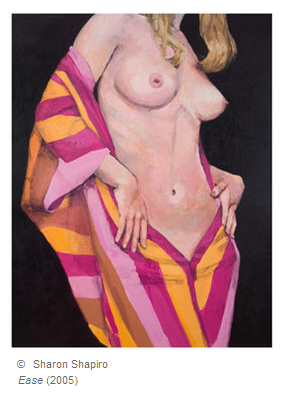 Worry about drugs and alcohol in the middle schools, not paintings on a midtown gallery wall. Better yet, teach your sons and daughters to love their bodies as they are, and to treat them with respect.
Worry about drugs and alcohol in the middle schools, not paintings on a midtown gallery wall. Better yet, teach your sons and daughters to love their bodies as they are, and to treat them with respect.Fame as a Feminist Issue?
I won’t belabor the point any longer except to say: close-minded throwbacks, one, art patrons, zero.
But the real question for me is why a painter of this caliber isn’t hanging in the permanent collections of our museums, though clearly, Atlanta may not be a contender for a Shapiro piece, and more’s the pity.
Still, is it the fact that her feminist message is not facile? Not sufficiently “feminist,” and likewise, not pop culture enough to accommodate easy classification?
Why aren’t we encouraging our men and women of any age to revisit our social constraints and human ambiguities? And why does the machinery of the art world continue to favor its men?
Stieglitz image: Clarence H. White and Alfred Stieglitz. Original uploader was Dustingc aten.wikipedia
Shapiro images: Courtesy the artist, and Poem88, Tanner Hill Gallery, Atlanta.
